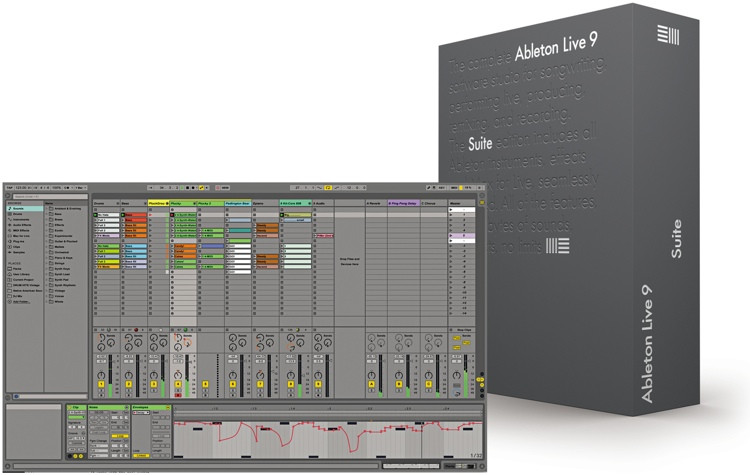Ableton Live 9 Specs
Cpu requirements for live 9 Post by arkboymusic » Thu Jun 22, 2017 11:56 pm Basically, I have an 8GB RAM i5 desktop which runs both FL Studio and Ableton just fine. Push $599; Live Suite 9 $749; Live Standard 9 $449; Live Intro 9 $99. Upgrades for Suite and Standard users from $149 depending on version. Ableton US +1 646 723 4550. Ableton Live 9's updated effects work and sound better than ever. It's been three years since Live 8, so it seems fair to expect big things from this update.
I don't use Ableton in a live setting (yet), but I do use the software daily on a couple different computers so I can get you going in the right direction. The gold standard for DJs and live performers seems to be the but I'm guessing since you don't want to spend much this will be above your price range (same for me, and I prefer PC anyway so I've been looking around for a good laptop to run Ableton as well).Basically, you want a multi-core processor (Intel i5 or i7 would be ideal), at least 4GB of RAM (8 or more would be preferable), a SSD hardrive for speed (depending on if you use a lot of samples you can get away with as little as 128GB but I would prefer at least 256 or up to 500GB for an SSD). Also, USB 3.0 for connecting newer/faster audio interfaces.
Most of these specs come standard on the $500+ laptops these days, it is really a great time to be in the market as the prices on hardware are getting very low and you can get a lot for your money. I won't go into specific models/brands, but if you follow the above guidelines you can get something that will cover your needs. Also keep an eye on battery life, depending on your setup you may want to have the option to play a gig without having the plug the laptop into the power outlet.If you want to go under $500, you are going to have to skip on one or more of the above specs.
If you aren't using samples you can probably get away with a 7200 RPM Hard drive (non-SSD), and maybe 4GB of RAM with an i5 processor. Also I don't like or need a touchscreen for my uses, so if you are the same you can save some money by forgoing the touch-capabilities.Also, aside from just checking the software minimum requirements, see what Ableton has to say on the subject. One more thing to remember- Ableton can be run in 32 or 64bit versions. On a 64bit computer, you can install Ableton in either 32 or 64bit mode.
Ableton Live 9 Intro Specs
The downside to a 32bit computer is it can't make use of more than 4GB of RAM, though for most basic applications 4GB should be enough. The downside to installing Ableton in 64bit is that a lot of older VSTs (and some current ones) don't have 64bit versions, so you don't have quite the options when it comes to software synths and effects. Personally I use the 64bit version as I have 16GB of RAM and don't use any VSTs that aren't available in 64bit.–Sep 23 '14 at 2:19.
Snap-to-grid for MIDI notes is much better implemented than before. Small timing adjustments ignore the currently prescribed grid to allow free movement. Go beyond one grid square, however, and snap-to-grid kicks into action. The new position can either be on a grid line or it can maintain its relative grid offset. Conveniently, there's no need to designate this in advance with a global switch. Such things might seem like minor improvements, but when you're moving MIDI notes for hours on end, small changes can make a huge difference.There are similar workflow improvements throughout the software. Automation envelopes are quicker to create and edit, and there's support for curved paths between nodes.
It's also possible to save automation data as part of a loop in the performance-oriented Session View rather than just in the more conventional Arrangement View. This means that any changes to effects settings become part of the loop itself.
Ableton Live 9 Specs 1
It's even possible to make the automation repeat asynchronously with the loop to create interesting counter-rhythms.The EQ Eight effect has been overhauled, with an improved processing algorithm and the ability to adjust multiple bands simultaneously. The Compressor now has a scrolling waveform to show gain reduction over time. There's also a new Glue Compressor effect that uses analogue hardware modelling; its controls and sound closely resemble the classic Urei 1176 Peak Limiter.The deceptive first impression of Live 9's new features is typical of Ableton's approach to software design. Features such as Audio-to-MIDI conversion and effects automation would ordinarily be worthwhile workflow improvements. Xstory player command list 2017. Here, they transcend their utilitarian functions to become highly creative tools that unlock new ways of making music.It's odd that Live still lacks any form of Autotune-style vocal pitch manipulation, and this is one area where Cubase has a strong advantage. Another area is Cubase's tools for handling multiple takes, and we still find its nuts-and-bolts editing functions faster and more precise. However, nothing else matches Live's ability to inspire users to try new ideas.
Ableton Live 9 Specs

This alone makes it a huge success.